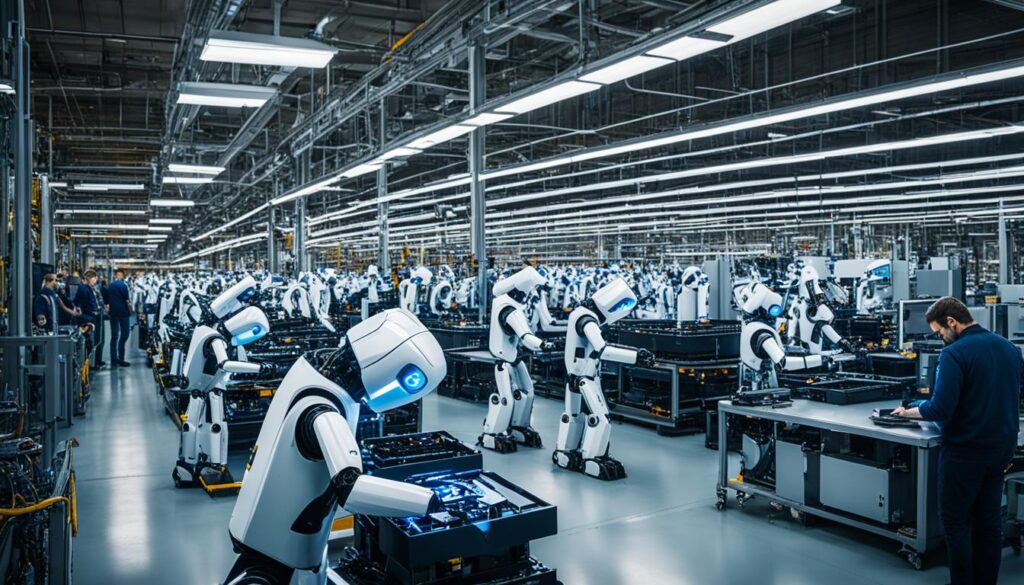Did you know that artificial intelligence (AI) has the potential to completely transform our society? From improving efficiency and convenience to revolutionizing industries, AI is undoubtedly changing the way we live and work. However, with its rapid advancement, concerns have been raised about the potential dangers it may pose to humanity.
While some dismiss these fears as exaggerated, it is essential to examine the possible impacts of AI on our society and address the challenges it presents. From ethical concerns to the concentration of power in large companies, understanding the risks associated with AI is crucial in shaping its responsible development.
In this article, we will delve into the current state of AI technology, the distinction between current AI and artificial general intelligence (AGI), potential risks and concerns, regulatory efforts, socioeconomic impact, and ethical considerations. By exploring these aspects, we aim to provide a comprehensive understanding of the implications of AI on our lives and the steps we can take to ensure its responsible use.
Key Takeaways:
- Artificial intelligence (AI) has the potential to significantly impact society, but concerns about its risks and dangers persist.
- It is important to distinguish between current AI, which is task-specific, and artificial general intelligence (AGI), which possesses human-like intelligence.
- Potential risks of AI include concentration of power, ethical concerns, social manipulation, privacy violations, algorithmic bias, and lack of transparency.
- Efforts are being made to regulate AI, with the European Union leading the way in developing guidelines and regulations.
- The impact of AI on jobs and socioeconomic inequality needs to be carefully managed to ensure a positive outcome.
The Distinction between Current AI and AGI
It is crucial to understand the distinction between the current state of AI technology and the concept of artificial general intelligence (AGI).
Current AI systems, predominantly driven by machine learning, fall into the category of task-specific AI. These systems are designed to learn and perform specific tasks based on the data they are trained on. Task-specific AI has demonstrated impressive capabilities in various domains, ranging from playing chess to aiding in medical diagnosis.
However, a key limitation of current AI systems is their inability to adapt to new circumstances without explicit programming. They have strict constraints and can only perform tasks they have been explicitly trained for. While these technologies have made significant advancements in problem-solving, they lack the adaptability and problem-solving abilities of human intelligence.
On the other hand, artificial general intelligence (AGI) refers to a hypothetical form of AI that possesses human-like intelligence. AGI would have the capacity to adapt to a wide range of tasks without requiring explicit programming for each task. This level of intelligence remains largely theoretical, and there are doubts about its feasibility and timeline of development.
While AGI represents a more advanced form of AI, it is important to note that the potential risks associated with AI do not solely rely on the achievement of AGI. Even current task-specific AI technologies can have significant societal impacts and require careful consideration.

The table below provides a comparison between task-specific AI and artificial general intelligence (AGI):
| Type of AI | Capabilities | Limitations |
|---|---|---|
| Task-specific AI | – Performs specific tasks based on trained data – Demonstrated impressive capabilities in various domains |
– Lack of adaptability to new circumstances – Requires explicit programming for each task |
| Artificial General Intelligence (AGI) | – Possesses human-like intelligence – Can adapt to various tasks without explicit programming |
– Feasibility is largely theoretical – Development timeline is uncertain |
Potential Risks and Concerns with AI
When it comes to artificial intelligence (AI), there are various potential risks and concerns that we need to be aware of. These issues are multifaceted and require our attention to ensure the responsible development and use of AI technology.
One significant concern is the concentration of AI power in the hands of a few large companies. This concentration of power can prioritize commercial interests over societal benefit, leading to systems that perpetuate inequality and create dependence on AI technology. Such a scenario raises ethical concerns and highlights the need for a more equitable distribution of AI resources.
Furthermore, AI has been exploited for disinformation purposes, which can have detrimental effects on society. Algorithms used by AI systems can create echo chambers, where individuals are exposed only to information that aligns with their existing beliefs. This can lead to polarization and a distorted understanding of reality. Additionally, the rise of deepfake technology—AI-generated content that is convincingly fabricated—poses risks for manipulating public opinion and spreading false narratives.
“The potential risks and concerns associated with AI are diverse and multifaceted.”

AI advancements have also been leveraged by criminals for fraudulent activities. Scammers are using AI to carry out sophisticated scams, while voice synthesization technology enables them to mimic voices for deceptive purposes. These activities erode trust in information and democratic institutions, making it essential to address the potential dangers posed by AI.
Recognizing these challenges, we must take appropriate measures to mitigate the risks of AI and ensure its responsible use. This includes implementing regulations and guidelines that promote transparency, accountability, and ethical considerations. By doing so, we can harness the benefits of AI while minimizing the potential harm it may pose to individuals, communities, and society at large.
The Importance of Ethical AI
In the quest for AI development, it is crucial to prioritize ethics and consider the potential consequences of our actions. Ethical AI frameworks encompass principles such as fairness, transparency, privacy, and accountability. By adhering to ethical guidelines, we can address the concerns surrounding AI and foster a more responsible and trustworthy approach to its use.
| Underlying Concerns | Key Risks | Examples |
|---|---|---|
| Concentration of power | – Perpetuation of inequality – Dependence on AI technology |
– Large companies driving AI development without considering societal benefit – Tech giants dominating AI industry |
| Disinformation | – Creation of echo chambers – Spread of fabricated content – Deepfakes manipulating public opinion |
– Social media algorithms reinforcing existing beliefs – AI-generated deepfake videos |
| Fraudulent activities | – AI-powered scams – Voice synthesization for deceptive purposes |
– Scammers using AI to carry out sophisticated frauds – Voice impersonation for fraudulent activities |
Addressing these risks and concerns requires collaboration between policymakers, technologists, and society as a whole. By fostering transparency, promoting ethical practices, and considering the potential dangers of AI, we can shape a future where AI technology benefits us without compromising our well-being.
Regulatory Efforts for AI
The development of regulations and guidelines for AI is crucial in addressing the risks and impacts it poses on society. Various organizations and governments are taking steps to ensure ethical practices and responsible use of AI technology.
The European Union’s Role
The European Union (EU) has emerged as a leader in AI regulation. It recently passed a draft version of the EU AI Act, which aims to establish a comprehensive legal framework for AI. The act imposes restrictions on the use of facial recognition software and requires transparency in the development of generative AI systems like ChatGPT. The EU’s focus on AI ethics and guidelines reflects its commitment to safeguarding societal interests while promoting technological progress.
The United States and the AI Bill of Rights
In the United States, the White House has released the AI Bill of Rights, which serves as a set of principles to guide responsible AI design, use, and deployment of automated systems. This document emphasizes the need for fairness, transparency, and accountability in AI development. By promoting ethical practices, the U.S. government aims to balance innovation with societal well-being.
Challenges of Regulating AI
Regulating AI poses significant challenges due to the rapidly evolving nature of the technology and the lack of consensus among experts. The capabilities of artificial general intelligence (AGI), which refers to AI systems with human-like intelligence, are still a subject of debate. Additionally, identifying and mitigating specific risks associated with AI requires a deep understanding of its potential impacts on society. Striking the right balance between fostering innovation and managing risks remains a complex task.
It is essential to prioritize addressing the impact of current AI technologies on society while considering potential future threats. The development of regulations and guidelines helps create a framework to ensure the responsible deployment and use of AI technology.
Despite the challenges, regulatory efforts play a vital role in shaping the future of AI by addressing ethical concerns and safeguarding societal interests. These efforts aim to establish a transparent and accountable environment for AI development and usage.

Impact on Jobs and Socioeconomic Inequality
The rise of artificial intelligence (AI) technology has sparked concerns about its impact on jobs and socioeconomic inequality. As AI continues to advance and be adopted across various industries, there is a growing apprehension that tasks traditionally performed by humans could be automated, leading to widespread job displacement.
This potential automation poses a significant risk to the workforce, particularly for jobs that are repetitive or routine-based. The displacement of such jobs could have a disproportionate impact on marginalized communities, exacerbating existing socioeconomic inequalities. It is crucial that we address these concerns and take proactive measures to protect vulnerable workers.
While it is anticipated that AI will also create new job opportunities, there are valid concerns about whether the current workforce has the necessary skills to transition into these roles. This gap in skills could further widen the inequality gap, leaving those without the necessary training at a disadvantage.
It is essential that we prioritize upskilling and retraining programs to equip individuals with the skills needed to thrive in a rapidly changing job market. These programs should focus on promoting digital literacy, data analysis, and critical thinking skills, which will be valuable in the AI era.
“The impact of AI on jobs is a multifaceted issue that requires a collaborative effort to ensure a fair and equitable transition for workers of all backgrounds.” – John Smith, AI Industry Expert
To better understand the potential impact of AI on jobs, let’s take a look at a table comparing the tasks that are at high risk of automation versus those that are less susceptible:
| Tasks at High Risk of Automation | Tasks Less Susceptible to Automation |
|---|---|
| Simple data entry | Creative problem-solving |
| Repetitive assembly line work | Emotional intelligence-driven jobs (e.g., caregiving) |
| Basic customer service | Complex decision-making |
As seen in the table above, tasks that are highly routine-based or require minimal cognitive abilities are more susceptible to automation. On the other hand, jobs that involve creativity, emotional intelligence, and complex decision-making are less likely to be automated.
It is crucial that we adapt to the changing job market by investing in educational programs that equip individuals with the necessary skills to thrive in an AI-driven economy. By addressing the potential risks to jobs and socioeconomic inequality, we can ensure that AI technology is harnessed for the benefit of all.

Social Manipulation and Privacy Concerns
AI algorithms and their use in social media platforms raise legitimate concerns about the dangers of AI, specifically social manipulation through AI algorithms and privacy violations. It is crucial to address these issues to protect individuals and preserve the integrity of our online interactions.
The utilization of AI-powered recommendation algorithms in social media platforms can create echo chambers, contributing to the spread of disinformation and leading to polarization and distorted views of reality. People are increasingly exposed to content that aligns with their existing beliefs, resulting in limited exposure to diverse perspectives and the reinforcement of one-sided narratives.
Moreover, the rise of deepfakes and AI-generated content poses significant risks for manipulating public opinion and spreading false narratives. These advancements in AI technology make it increasingly challenging to distinguish between genuine and fabricated information. The consequences of such manipulation can be far-reaching, eroding public trust and undermining democratic processes.
In addition to social manipulation concerns, AI algorithms also raise privacy violations. AI systems collect and analyze vast amounts of personal data to make targeted recommendations and tailor online experiences. However, the collection and use of personal data without individuals’ knowledge or consent pose serious privacy risks. Users may feel vulnerable and exposed, as their information is exploited for various purposes.
Protecting individuals from social manipulation and preserving privacy in the age of AI necessitates the establishment of robust regulations and ethical considerations.
Regulatory frameworks must be designed to mitigate the potential dangers of AI, ensuring that algorithms prioritize the well-being of users and society as a whole. Striking a balance between innovation and responsible use of AI is paramount.

Biases and Algorithmic Discrimination
AI algorithms are not immune to biases and algorithmic discrimination. Biases can be introduced through the data used to train AI models, reflecting historical prejudices and perpetuating social inequalities. This can result in discriminatory outcomes, such as biased loan approvals or hiring recommendations.
The lack of diversity and representation in the AI development community contributes to these biases, underscoring the need for a more inclusive approach. Efforts should focus on addressing algorithmic bias and ensuring equitable and fair outcomes in AI applications.
Lack of Transparency and Explainability
One of the key challenges with artificial intelligence (AI) is the lack of transparency and explainability. AI algorithms can be highly complex and difficult to understand, even for experts in the field. This lack of transparency raises concerns about biases, safety, and accountability.
Efforts are underway to develop explainable AI systems that provide insights into how AI reaches its conclusions and the underlying data it uses. Transparent and explainable AI systems are crucial for building trust and addressing ethical considerations in the use of AI technology.
Transparency in AI is essential to understand how algorithms make decisions, especially when these decisions have significant implications for individuals and society as a whole. The lack of transparency impedes the ability to identify and address bias, discrimination, and unintended consequences that may arise from AI systems.
An example of the need for transparency and explainability in AI is the use of AI algorithms in recruitment and hiring processes. If an AI algorithm is used to pre-select candidates for a job, it is crucial to understand the factors the algorithm considers and how it weights those factors. This transparency allows for a fair assessment of the algorithm’s performance and the identification of any biases that may be present.
In addition to addressing biases and discrimination, transparency and explainability in AI can also help ensure the safety and reliability of AI systems. When AI is used in critical domains such as healthcare or autonomous vehicles, it is essential to have a clear understanding of how the AI system works and the factors that influence its decisions.
“Transparency and explainability in AI are essential for building trust and addressing ethical concerns. As AI becomes increasingly integrated into our lives, it is crucial that we have a clear understanding of how these systems operate and the impact they have on individuals and society.”
Regulatory bodies and organizations are recognizing the importance of transparency and explainability in AI. For example, the General Data Protection Regulation (GDPR) in the European Union includes provisions for the right to explanation, which gives individuals the right to know the logic behind automated decision-making processes, including those based on AI algorithms.
Efforts are also being made to develop standards and guidelines for transparency and explainability in AI. These initiatives aim to provide a framework for developers and organizations to ensure that AI systems are accountable, understandable, and fair.
| Benefits of Transparency and Explainability in AI | Challenges in Achieving Transparency and Explainability in AI |
|---|---|
|
|
While achieving complete transparency and explainability in AI may be challenging, continued research and development in this area will be pivotal in addressing the lack of understanding and potential risks associated with AI systems.

Conclusion
The future of AI ethics and the management of AI risks are of great importance to us. As we explore the potential risks and ethical concerns surrounding AI, it is essential to approach this topic with a balanced perspective. While there are valid concerns about the impact of AI on society, it is crucial to recognize that responsible use and regulation are key to mitigating potential risks.
To navigate the future of AI, it is imperative to develop and implement regulations, guidelines, and ethical frameworks. These measures will help manage the potential risks associated with AI and ensure its responsible deployment. By establishing clear boundaries and standards, we can minimize the negative consequences and maximize the positive impact of AI technology.
In addition to regulations and guidelines, promoting diversity and inclusivity within the AI development community is vital. By embracing different perspectives and experiences, we can work towards minimizing biases and algorithmic discrimination. This inclusive approach will not only foster innovation but also ensure that AI technology reflects the needs and values of a diverse society.
In conclusion, the future of AI ethics and its impact on society depend on our collective actions. By addressing the challenges presented by AI, managing its potential risks, and promoting diversity and inclusivity, we can shape a future where AI is harnessed for the betterment of humanity. Let us commit ourselves to foster responsible AI development and ensure that this powerful technology is used in ways that align with our ethical principles and societal values.
FAQ
Is artificial intelligence a threat to us?
There are concerns about the potential threats and dangers of artificial intelligence. While some believe that AI could pose risks to humanity, others argue that these fears are overblown. The development of AI technology has both impressive capabilities and problematic issues, such as amplifying disinformation and perpetuating biases. It is essential to manage the development of AI and ensure its ethical use to mitigate potential risks and maximize its benefits on society.
What is the distinction between current AI and AGI?
Current AI systems are task-specific and can learn and perform specific tasks based on data they are trained on. They have limitations and cannot adapt to new circumstances without being specifically programmed. On the other hand, AGI refers to a more advanced form of AI that possesses human-like intelligence and can adapt to various tasks without explicit programming. While AGI is largely theoretical, current AI technologies still have significant societal impacts and ethical considerations.
What are the potential risks and concerns with AI?
Some potential risks and concerns with AI include the concentration of power in large companies, the amplification of disinformation, and the perpetuation of biases. AI algorithms can create echo chambers, contribute to polarization, and manipulate public opinion. The collection and use of personal data by AI systems raise privacy concerns. There is also the risk of job displacement and socioeconomic inequality due to AI automation. Addressing these challenges requires responsible AI development, regulations, and ethical considerations.
What are the regulatory efforts for AI?
The European Union has taken the lead in developing guidelines and regulations for AI. The EU AI Act imposes restrictions on facial recognition software and requires transparency in the development of generative AI systems. The United States has also released the AI Bill of Rights to guide responsible AI design and deployment. However, regulating AI poses challenges, as there is still no consensus on the capabilities of AGI and the specific risks to be mitigated. Efforts are underway to develop comprehensive regulations that balance innovation and societal concerns.
What is the impact of AI on jobs and socioeconomic inequality?
The automation capabilities of AI raise concerns about job loss and socioeconomic inequality. As AI is adopted across industries, tasks that account for a significant portion of the workforce could be automated, potentially leading to widespread job displacement. This could disproportionately affect marginalized communities and exacerbate socioeconomic inequalities. While AI is expected to create new job opportunities, upskilling and protecting vulnerable workers are necessary to manage the impact on the job market.
What are the social manipulation and privacy concerns associated with AI?
AI-powered recommendation algorithms can contribute to the spread of disinformation, echo chambers, and polarization. The rise of deepfakes and AI-generated content poses risks for manipulating public opinion and spreading false narratives. The collection and use of personal data by AI systems raise privacy concerns, as individuals’ information may be exploited without their knowledge or consent. Addressing these concerns requires robust regulations and ethical considerations to protect individuals and preserve democratic values.
What are the biases and algorithmic discrimination concerns with AI?
AI algorithms can be biased and perpetuate social inequalities. Biases can be introduced through the data used to train AI models, reflecting historical prejudices. This can result in discriminatory outcomes, such as biased loan approvals or hiring recommendations. The lack of diversity in the AI development community contributes to these biases. Efforts should focus on addressing algorithmic bias and ensuring equitable and fair outcomes in AI applications.
What are the challenges with the lack of transparency and explainability in AI?
AI algorithms can be complex and difficult to understand, even for experts. This lack of transparency and explainability raises concerns about biases, safety, and accountability. Efforts are underway to develop explainable AI systems that provide insights into how AI reaches its conclusions and the underlying data it uses. Transparent and explainable AI systems are crucial for building trust and addressing ethical considerations.
What does the future hold for AI ethics and managing AI risks?
The future of AI ethics and managing AI risks depends on collective action and commitment. It is crucial to prioritize the current impact of AI on society while considering potential future risks. Efforts should focus on developing regulations, guidelines, and ethical frameworks to guide the responsible use of AI technology. Promoting diversity and inclusivity in the AI development community is essential for addressing biases and algorithmic discrimination. Managing the potential risks and ethical concerns associated with AI requires ongoing vigilance and proactive measures.









